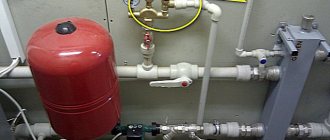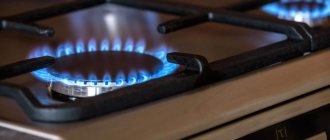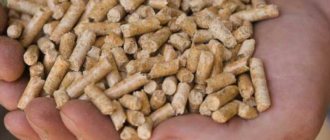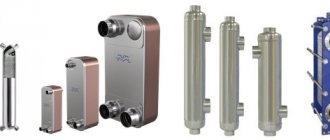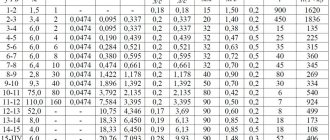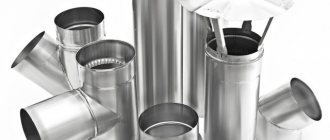What determines the amount of heat?
The internal energy of a body changes when work is performed or heat is transferred.
In the phenomenon of heat transfer, internal energy is transferred by conduction, convection or radiation. Each body, when heated or cooled (through heat transfer), gains or loses some amount of energy. Based on this, it is customary to call this amount of energy the amount of heat.
So, the amount of heat is the energy that a body gives or receives during the process of heat transfer.
How much heat is needed to heat water? Using a simple example, you can understand that heating different amounts of water will require different amounts of heat. Let's say we take two test tubes with 1 liter of water and 2 liters of water. In which case will more heat be required? In the second, where there are 2 liters of water in a test tube. The second test tube will take longer to heat up if we heat them with the same fire source.
Thus, the amount of heat depends on body mass. The greater the mass, the greater the amount of heat required for heating and, accordingly, the longer it takes to cool the body.
What else does the amount of heat depend on? Naturally, from the difference in body temperatures. But that is not all. After all, if we try to heat water or milk, we will need different amounts of time. That is, it turns out that the amount of heat depends on the substance of which the body consists.
As a result, it turns out that the amount of heat that is needed for heating or the amount of heat that is released when a body cools depends on its mass, on the change in temperature and on the type of substance of which the body is composed.
Gcal in private homes
If we talk about Gcal in a private house, then residents are primarily interested in the cost of heat energy for each type of fuel. Therefore, let’s look at some prices per 1 Gcal for various types of fuel:
- Natural gas – 3300 rubles;
- Liquefied gas – 520 rubles;
- Coal – 550 rubles;
- Pellets – 1800 rubles;
- Diesel fuel – 3270 rubles;
- Electricity – 4300 rubles.
The price may vary depending on the region, and it is also worth considering that the cost of fuel increases periodically.
How is the amount of heat measured?
A unit of heat is considered to be 1 Joule . Before the advent of the unit of measurement of energy, scientists considered the amount of heat as calories. This unit of measurement is usually abbreviated as “J”
A calorie is the amount of heat required to heat 1 gram of water by 1 degree Celsius. The abbreviated form of calorie measurement is “cal”.
1 cal = 4.19 J.
Please note that in these energy units it is customary to indicate the nutritional value of foods in kJ and kcal.
1 kcal = 1000 cal.
1 kJ = 1000 J
1 kcal = 4190 J = 4.19 kJ
Formula for calculating Gcal for heating
If you do not have an individual device, then you need to use the following formula for calculating heat for heating: Q = V * (T1 – T2) / 1000, where:
- Q is the total amount of heat energy.
- V is the volume of hot water consumption. Measured in tons or cubic meters.
- T1 is the hot water temperature, measured in degrees Celsius. In such a calculation, it is better to take into account the temperature that will be characteristic of a specific operating pressure. This indicator is called enthalpy. If there is no necessary sensor, then take the temperature that will be similar to the enthalpy. Typically, the average temperature is between 60-65 degrees Celsius.
- T2 is the temperature of cold water, which is measured in degrees Celsius. As you know, getting to a pipeline with cold water is not easy, so such values are determined by constant values. They, in turn, depend on the climatic conditions outside the house. For example, in the cold season, this value can be 5 degrees, and in warm times, when there is no heating, it can reach 15 degrees.
- 1000 is a factor that gives the answer in gigacalories. This value will be more accurate than regular calories.
In a closed heating system, gigacalories are calculated in a different form. In order to calculate Gcal in a closed heating system, you must use the following formula: Q = ((V1 * (T1 - T)) - (V2 * (T2 - T))) / 1000, where:
- Q – previous volume of thermal energy;
- V1 is the heat carrier flow rate parameter in the supply pipe. The heat source can be water vapor or ordinary water.
- V2 – volume of water flow in the outlet pipe;
- T1 – temperature in the coolant supply pipe;
- T2 – temperature at the pipe outlet;
- T – cold water temperature.
Calculation of thermal energy for heating using this formula depends on two parameters: the first shows the heat that enters the system, and the second is the heat parameter when the coolant is removed through the return pipe.
What is specific heat capacity
Each substance in nature has its own properties, and heating each individual substance requires a different amount of energy, i.e. amount of heat.
The specific heat capacity of a substance is a value equal to the amount of heat that must be transferred to a body with a mass of 1 kilogram in order to heat it to a temperature of 1 0C
Specific heat capacity is designated by the letter c and has a measurement value of J/kg*
For example, the specific heat capacity of water is 4200 J/kg*0C. That is, this is the amount of heat that needs to be transferred to 1 kg of water to heat it by 1 0C
It should be remembered that the specific heat capacity of substances in different states of aggregation is different. That is, heating ice by 1 0C will require a different amount of heat.
Other methods for calculating Gcal for heating
You can calculate the amount of heat that enters the heating system in other ways. For example, the formula for calculating Gcal can have two other forms:
- Q = ((V1 * (T1 - T2)) + (V1 - V2) * (T2 - T)) / 1000.
- Q = ((V2 * (T1 - T2)) + (V1 - V2) * (T1 - T)) / 1000.
All values in these formulas are the same as in the previous formula. Based on the above calculations, we can conclude that you can calculate Gcal for heating yourself. But you should seek advice from special companies that are responsible for supplying heat to the house, since their work and calculation system may differ from these formulas and consist of a different set of measures.
If you decide to make a “Warm Floor” system in your private home, then the principle of heating calculation will be completely different. The calculation will be much more complicated, since it is necessary to take into account not only the features of the heating circuit, but also the values of the electrical network from which the floor is heated. The companies that are responsible for monitoring the installation of heated floors will be different.
Many residents have difficulty converting kilocalories to kilowatts. This is due to many manuals of measuring units in the international system, which is called “C”. When converting kilocalories to kilowatts, the coefficient 850 should be used. That is, 1 kW equals 850 kcal. This calculation is much simpler than others, since it is not difficult to find out the required volume of gigacalories. 1 gigacalorie = 1 million calories.
During the calculation, it should be remembered that any modern devices have a small error. Mostly they are acceptable. But you need to calculate the error yourself. For example, this can be done using the following formula: R = (V1 - V2) / (V1+V2) * 100, where:
- R – error of a common house heating device.
- V1 and V2 are the previously indicated water flow parameters in the system.
- 100 is the coefficient that is responsible for converting the resulting value into a percentage. In accordance with operational standards, the maximum error that can be is 2%. Basically, this figure does not exceed 1%.
How to calculate the amount of heat to heat a body
For example, it is necessary to calculate the amount of heat that needs to be spent in order to heat 3 kg of water from a temperature of 15 0C to a temperature of 85 0C. We know the specific heat capacity of water, that is, the amount of energy needed to heat 1 kg of water by 1 degree. That is, in order to find out the amount of heat in our case, you need to multiply the specific heat capacity of water by 3 and by the number of degrees by which you want to increase the water temperature. So that's 4200*3*(85-15) = 882,000.
In brackets we calculate the exact number of degrees, subtracting the initial result from the final required result
So, in order to heat 3 kg of water from 15 to 85 0C, we need 882,000 J of heat.
The amount of heat is denoted by the letter Q, the formula for calculating it is as follows:
Q=c*m*(t2-t1).
Heat meters
In order to calculate thermal energy you need to know the following information:
- The temperature of the liquid at the inlet and outlet of a certain section of the pipeline.
- The flow rate of liquid that moves through heating devices.
Consumption can be determined using heat meters. Heat meters can be of two types:
- Vane counters. Such devices are used to measure thermal energy, as well as hot water consumption. The difference between such meters and devices for metering cold water is the material from which the impeller is made. In such devices it is most resistant to high temperatures. The operating principle is similar for the two devices:
- The rotation of the impeller is transmitted to the metering device;
- The impeller begins to rotate due to the movement of the working fluid;
- The transfer is carried out without direct interaction, but with the help of a permanent magnet.
Such devices have a simple design, but their response threshold is low. They also have reliable protection against reading distortion. Using an antimagnetic screen, the impeller is prevented from braking by the external magnetic field.
- Devices with a difference recorder. Such meters operate according to Bernoulli's law, which states that the speed of a liquid or gas flow is inversely proportional to its static movement. If the pressure is recorded by two sensors, the flow can be easily determined in real time. The counter involves electronics in the design. Almost all models provide information on the flow and temperature of the working fluid, and also determine the consumption of thermal energy. You can configure the work manually using a PC. You can connect the device to a PC via a port.
Many residents are wondering how to calculate the amount of Gcal for heating in an open heating system in which hot water can be selected. Pressure sensors are installed on the return and supply pipes at the same time. The difference in the flow rate of the working fluid will show the amount of warm water that was spent for domestic needs.
Results of calculations of Gcal for heating

If you have correctly calculated the consumption of Gcal of thermal energy, then you do not have to worry about overpayments for utilities. If we use the above formulas, we can conclude that when heating a residential building with an area of up to 200 sq.m. you will need to spend about 3 Gcal in 1 month. If we consider that the heating season in many regions of the country lasts approximately 6 months, then we can calculate the approximate consumption of thermal energy. To do this, multiply 3 Gcal by 6 months and get 18 Gcal.
It is much easier to calculate gigacalorie consumption in a private home, since you can install your own individual device there. In apartment buildings with centralized heating, it will not be possible to get by with a conventional appliance.
Based on the information indicated above, we can conclude that all calculations on the consumption of thermal energy in a particular house can be done independently without the help of special organizations. But it is worth remembering that all data must be calculated accurately using special mathematical formulas. In addition, all procedures must be coordinated with special bodies that control such actions. If you are not sure that you will perform the calculation yourself, then you can use the services of professional specialists who are engaged in such work and have materials available that describe in detail the entire process and photos of heating system samples, as well as their connection diagrams.
Source: https://baltgazservice.ru/
Post Views: 42
Thermal machines. Efficiency formula in thermodynamics
A heat engine , in its simplest case, consists of a heater, a refrigerator and a working fluid. The heater imparts heat to the working fluid, it does work, then it is cooled by the refrigerator, and everything repeats again. A typical example of a heat engine is an internal combustion engine.
The efficiency of a heat engine is calculated using the formula
So we have collected the basic formulas of thermodynamics that will be useful in solving problems. Of course, these are not all the formulas from the topic of thermodynamics, but knowledge of them can really serve you well. And if you have any questions, remember about the student service , whose specialists are ready to come to the rescue at any time.

